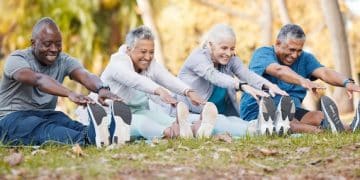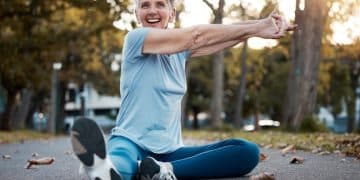Best 5 Exercises for Seniors: Improve Balance & Prevent Falls
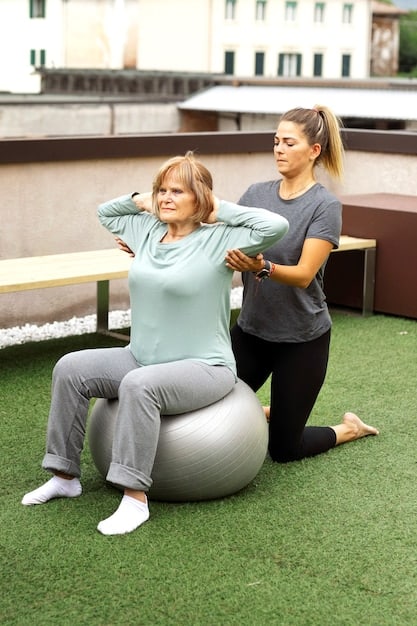
Maintaining strong balance and preventing falls is crucial for seniors, and incorporating specific exercises into a routine can significantly mitigate these risks, enhancing overall independence and quality of life.
As we age, maintaining our physical capabilities, particularly balance, becomes increasingly vital. Falling can have serious consequences for older adults, from minor injuries to life-altering fractures, significantly impacting independence and quality of life. This article explores The 5 Best Exercises for Seniors to Improve Balance and Prevent Falls, offering practical, evidence-based approaches to enhance stability and reduce risk.
Understanding the Importance of Balance Training
Balance is a complex function, integrally linked to our ability to move safely and confidently through daily life. For seniors, a decline in balance can be attributed to various factors, including muscle weakness, reduced flexibility, impaired vision, and certain medical conditions or medications. Recognizing these underlying causes is the first step toward effective intervention.
Engaging in targeted balance exercises is not merely about physical strength; it’s about re-calibrating the body’s proprioceptive system—its sense of position and movement. This system relies on a continuous feedback loop between muscles, joints, and the brain. Consistent practice helps refine these pathways, leading to more responsive and stable movements. The benefits extend beyond fall prevention, encompassing improved coordination, enhanced mobility, and a greater sense of self-efficacy in navigating various environments.
The Science Behind Balance Improvement
Research consistently demonstrates that specific exercises can significantly improve balance in older adults. These exercises often focus on three key areas: strength, flexibility, and dynamic stability. Strength training builds the muscle groups essential for supporting the body and recovering from minor stumbles. Flexibility ensures that joints can move through their full range of motion without restriction, which is critical for maintaining an upright posture. Dynamic stability drills challenge the body’s ability to maintain balance while in motion, mimicking real-world scenarios like walking on uneven surfaces or reaching for objects.
Moreover, exercises that incorporate elements of cognitive engagement, such as tai chi, have been shown to be particularly effective. The mindful execution of movements in these disciplines simultaneously trains the body and the brain, enhancing reaction time and spatial awareness. It’s a holistic approach that acknowledges the intricate connection between mental and physical well-being in maintaining stability.
- Proprioceptive Enhancement: Exercises like standing on one leg help retrain the body’s sensing mechanisms.
- Muscle Strength: Stronger legs and core provide a stable foundation for balance.
- Dynamic Stability: Moving while maintaining balance, crucial for everyday activities.
Ultimately, a comprehensive balance training program should be progressive, starting with simple exercises and gradually increasing in difficulty as balance improves. It should also be tailored to individual capabilities and preferences, ensuring long-term adherence and maximum benefit. Working with a healthcare professional or physical therapist can help design a safe and effective regimen, considering any pre-existing conditions or limitations. This personalized approach maximizes safety and efficacy, promoting consistent engagement and measurable improvements over time.
Exercise 1: Heel-to-Toe Walk
The heel-to-toe walk, often referred to as tandem walking, is a fundamental exercise for improving balance and coordination. It directly challenges your stability by narrowing your base of support, simulating situations where maintaining a straight line is crucial, like walking through a crowded hallway or navigating a narrow path. This exercise primarily targets the core muscles and those in the legs, while also enhancing proprioception—your body’s awareness of its position in space.
To perform the heel-to-toe walk, find a clear, open space. Begin by placing the heel of one foot directly in front of the toes of the other foot, so they are touching or nearly touching. Imagine walking on a tightrope, keeping your body as upright as possible. Take slow, deliberate steps, focusing on maintaining your balance with each movement. It’s helpful to look a few feet ahead rather than directly at your feet, which can improve overall stability. Initially, you might find it challenging to maintain a straight line, but with consistent practice, your control and confidence will improve significantly.
Progression and Safety Tips
As you become more comfortable, you can increase the difficulty of the heel-to-toe walk. One way is to increase the distance you walk in this tandem fashion. Another progression involves performing the exercise with your eyes closed for short periods, but only if you have a stable support nearby, such as a wall or a sturdy piece of furniture, for safety. This advanced variation further challenges your proprioceptive system, forcing your body to rely less on visual cues and more on internal signals for balance.
- Start Small: Begin with 5-10 steps and gradually increase as you gain confidence.
- Use Support: If needed, walk alongside a wall or use a sturdy chair for support.
- Maintain Posture: Keep your gaze forward, shoulders relaxed, and core engaged.
Safety is paramount with any balance exercise, especially for seniors. Always perform the heel-to-toe walk in a well-lit area free of obstacles. If you’re concerned about falls, have a family member or caregiver present, or practice near a wall that you can lightly touch for support. Wear comfortable, supportive shoes with good grip. Avoid doing this exercise if you feel dizzy or unwell. Regular practice, even for a few minutes each day, can lead to substantial improvements in your balance and reduce your risk of falls, empowering you to move with greater ease and confidence.
Exercise 2: Single-Leg Stand
The single-leg stand is arguably one of the most effective and straightforward exercises for enhancing balance. Its simplicity belies its profound impact on strengthening the muscles responsible for stability, particularly those in the ankles, calves, and core. By requiring your body to balance on one leg, it challenges your proprioceptive system to a greater degree, improving your ability to make tiny adjustments that keep you upright.
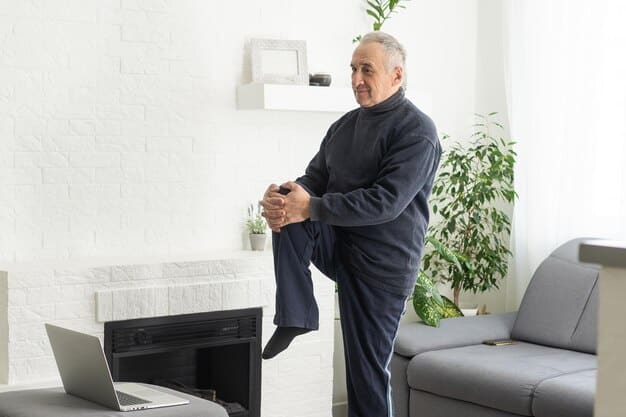
To begin, stand tall with your feet hip-width apart. Shift your weight slightly onto one leg, then slowly lift the other foot off the ground. Aim to keep your lifted foot close to the ground initially, perhaps just an inch or two high. Focus on a fixed point in front of you to help maintain your gaze and balance. Engage your core muscles—imagine pulling your belly button towards your spine—as this provides a stable foundation for your upper body. Try to hold this position for 10-15 seconds, then switch legs. As you become more proficient, gradually increase the duration of your hold.
Variations and Advanced Techniques
Once you are comfortable holding the single-leg stand for a sustained period, you can introduce variations to further challenge your balance. A common progression is to increase the height of your lifted leg, perhaps bringing your knee up towards your chest. Another effective variation is to close your eyes, which significantly increases the demand on your proprioceptive system. However, this should only be attempted when you have a stable support source nearby, such as a wall or a counter, to prevent falls.
- Wall Support: Initially, use a wall or chair for light support.
- Gradual Progression: Start with short holds and increase duration as balance improves.
- Engage Core: A strong core is vital for maintaining stability.
To make the exercise more dynamic, you can try performing small, controlled arm movements while on one leg, such as extending your arms out to the sides or gently swinging them back and forth. This adds an additional dimension of challenge, mimicking everyday movements where you might need to adjust your balance while performing other tasks. Remember to practice consistently, ideally daily, for optimal results. Always choose repetitions and durations that feel safe and manageable, focusing on quality of movement over quantity. This exercise not only enhances physical balance but also builds confidence in navigating daily activities with greater stability and less fear of falling.
Exercise 3: Side Leg Raises
Side leg raises are an excellent exercise for strengthening the hip abductor muscles, which are crucial for maintaining balance during walking and standing. These muscles, located on the outer part of your hips, play a significant role in stabilizing your pelvis and preventing lateral sway, making them essential for fall prevention. By targeting these specific muscle groups, side leg raises contribute directly to improved stability and coordination, empowering you to move with greater confidence and control in daily activities.
To perform a side leg raise, stand tall with your feet hip-width apart, preferably near a wall or sturdy piece of furniture for support if needed. Slowly lift one leg out to the side, keeping it as straight as possible and ensuring your toes are pointed forward, not up. Avoid leaning your body to the opposite side as you lift; the goal is to isolate the movement to your leg and hip. Lift your leg as high as comfortable without feeling strain, then slowly lower it back to the starting position. Aim for 8-12 repetitions on each side, performing 2-3 sets.
Building Strength and Stability
Consistency is key to seeing benefits from side leg raises. As your hip abductor muscles strengthen, you’ll notice improved stability not just during the exercise, but also in your everyday movements. You might notice fewer instances of feeling off-balance when stepping sideways or navigating uneven terrain. To increase the challenge, you can perform the exercise without support, or introduce ankle weights as your strength improves. However, always prioritize proper form over adding weight, as incorrect form can lead to strain or injury.
Beyond the direct benefits to balance, side leg raises also contribute to overall lower body strength, which is fundamental for maintaining an active and independent lifestyle. Stronger leg muscles mean better support for your joints and a more efficient stride, reducing the effort required for walking and other mobility tasks. Incorporating this exercise into your routine several times a week can yield significant long-term benefits for your balance and overall physical well-being, helping you maintain your independence for years to come.
- Controlled Movement: Focus on slow, deliberate lifts and lowers.
- Don’t Lean: Keep your torso upright to maximize hip muscle engagement.
- Consider Resistance: Add ankle weights once the exercise without them becomes easy.
Remember to listen to your body and only go as far as comfortably possible. If you experience any pain, stop the exercise. It’s always advisable to consult with a healthcare professional or physical therapist before starting any new exercise program, especially if you have pre-existing health conditions or concerns about your balance. They can provide personalized guidance and ensure the exercises are appropriate for your individual needs and capabilities.
Exercise 4: Tai Chi
Tai Chi is much more than just a series of gentle movements; it’s a profound mind-body practice that has been scientifically proven to significantly improve balance, flexibility, and overall well-being, particularly among seniors. Originating in ancient China as a martial art, Tai Chi emphasizes slow, flowing motions, deep breathing, and mindful concentration. This unique combination makes it exceptionally effective for addressing the multifaceted nature of balance, integrating physical coordination with mental focus. Unlike many traditional exercises, Tai Chi gently challenges your stability without putting excessive stress on joints, making it highly accessible to individuals of varying fitness levels.
The practice involves a sequence of gracefully interconnected movements, performed in a continuous, unhurried manner. Each movement flows seamlessly into the next, promoting a sense of fluidity and harmony. Practitioners often describe a feeling of being “rooted” to the ground while their upper body moves with lightness and ease. This grounding sensation is central to Tai Chi’s balance-enhancing effects, as it strengthens the connection between your body and its spatial awareness. The slow pace allows for precise execution and deep internal focus, enhancing proprioception and kinesthetic awareness—your body’s ability to sense its own movement and position.
Benefits Beyond Balance
While improved balance is a primary benefit, Tai Chi offers a wealth of other advantages for seniors. Regular practice has been shown to reduce stress, improve cardiovascular health, boost immune function, and alleviate symptoms of conditions like arthritis and fibromyalgia. The meditative aspect of Tai Chi helps quiet the mind, reducing anxiety and promoting a sense of inner calm. This mental clarity, in turn, contributes to better physical coordination and reaction time, which are critical components of fall prevention.
Learning Tai Chi can be done through various avenues, including classes at community centers, specialized studios, or even online tutorials. Starting with a qualified instructor is highly recommended to ensure proper form and to fully grasp the foundational principles. The gentle yet powerful nature of Tai Chi means that consistency, even in short daily sessions, yields cumulative benefits. It’s an investment in your physical and mental health that pays dividends in improved balance, reduced fall risk, and an enhanced quality of life, allowing you to approach daily activities with greater ease and confidence.
- Holistic Approach: Integrates physical movement with mental focus.
- Gentle on Joints: Suitable for individuals with varying mobility levels.
- Stress Reduction: Promotes relaxation and mental clarity, aiding physical coordination.
Embracing Tai Chi means embracing a path toward greater stability, not just physically but also mentally. It teaches your body to respond more effectively to shifts in balance, thereby significantly reducing the likelihood of falls. Its serene pace makes it an enjoyable and sustainable practice, fostering a sense of accomplishment and contributing to a more active and fulfilling senior lifestyle.
Exercise 5: Standing March
The standing march is a deceptively simple yet highly effective exercise for improving dynamic balance, coordination, and lower body strength. It closely mimics the natural walking motion, making it a functional exercise that directly translates to enhanced stability in daily activities. By requiring you to lift one knee at a time while maintaining an upright posture, it challenges your core stability and the muscles in your legs, helping you develop a more robust and responsive balance system.
To execute the standing march, begin by standing tall with your feet hip-width apart, looking straight ahead. If you need support, stand near a wall or a sturdy chair. Slowly lift one knee towards your chest, aiming for a height that feels comfortable and safe, without compromising your balance. Ensure your standing leg remains straight but not locked at the knee. Hold the lifted position for a brief moment, engaging your core, then slowly lower your foot back to the starting position. Alternate legs, performing the movement in a controlled and deliberate manner. Aim for 10-15 repetitions on each leg, completing 2-3 sets.
Building Endurance and Coordination
Regular practice of the standing march will not only strengthen your leg and core muscles but also improve your proprioception—your body’s ability to sense its position and movement in space. This enhanced sensory feedback allows for quicker adjustments if you encounter uneven surfaces or unexpected shifts in balance. As you become more proficient, you can increase the challenge by lifting your knees higher, or by performing the exercise without support, encouraging your body to rely solely on its internal balance mechanisms. Incorporating arm swings, similar to those used during natural walking, can further enhance coordination and mimic real-life scenarios.
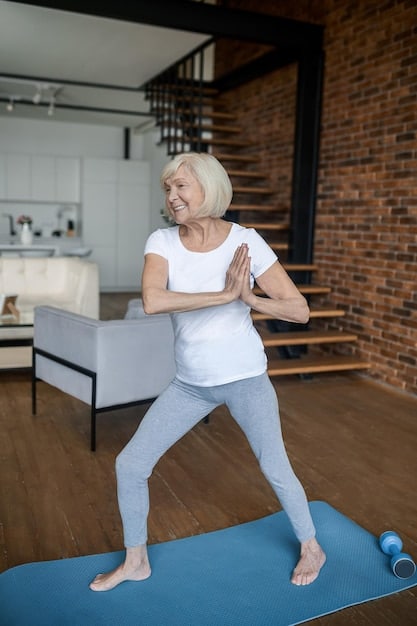
The beauty of the standing march lies in its versatility and low impact. It can be performed almost anywhere, without special equipment, making it an ideal addition to a daily exercise routine. It’s particularly beneficial for seniors who are working on improving their gait and reducing their risk of trips and falls. By strengthening the muscles responsible for lifting your feet and stabilizing your core, you’ll build greater confidence in your ability to walk safely and efficiently, contributing significantly to your overall independence and quality of life.
- Controlled Movement: Avoid rushing; focus on slow, deliberate lifts and lowers.
- Core Engagement: Tighten your core muscles to maintain stability.
- Add Arm Swings: Integrate natural arm movements to enhance coordination.
Always remember to prioritize safety. If you feel unsteady, use support. Wear appropriate footwear, and ensure your exercise area is clear of obstacles. Listen to your body and adjust the intensity as needed. Consistent effort with the standing march can bring remarkable improvements in your balance, preparing you to tackle daily challenges with greater ease and security.
| Key Exercise | Brief Description |
|---|---|
| 🚶♀️ Heel-to-Toe Walk | Improves coordination and straight-line balance by narrowing your base of support. |
| 🧍♂️ Single-Leg Stand | Strengthens ankle and core muscles, enhancing static balance and proprioception. |
| 🦵 Side Leg Raises | Targets hip abductors, crucial for lateral stability and preventing sideways falls. |
| 🧘♀️ Tai Chi | A mind-body practice that improves dynamic balance, flexibility, and coordination with gentle movements. |
Frequently Asked Questions About Balance Exercises
▼
For optimal results, seniors should aim to perform balance exercises at least 3-5 times a week. Consistency is more important than intensity, so even short, daily sessions can yield significant benefits. However, always listen to your body and adjust frequency based on energy levels and any physical limitations.
▼
Balance issues in seniors can stem from various factors, including age-related muscle weakness, reduced flexibility, impaired vision, inner ear problems, nerve damage, and certain medications. Conditions like arthritis, Parkinson’s disease, and diabetes can also significantly impact balance, requiring specialized management strategies.
▼
Exercises focusing on strength, flexibility, and dynamic balance are crucial for fall prevention. Examples include tai chi, heel-to-toe walks, single-leg stands, side leg raises, and standing marches. Incorporating activities that challenge the body’s stability in various ways helps prepare it for everyday situations.
▼
Yes, balance can be improved at any age with consistent effort and proper training. The body’s proprioceptive system and muscle strength are adaptable. Regular, targeted exercises can strengthen the muscles responsible for stability and enhance the nervous system’s ability to coordinate movements, regardless of age.
▼
It is highly recommended that seniors consult their doctor or a physical therapist before starting any new exercise program, especially if they have pre-existing health conditions or a history of falls. A healthcare professional can assess individual needs and recommend a safe, effective, and personalized regimen.
Conclusion
Improving balance and preventing falls is a foundational element of healthy aging, directly contributing to continued independence and an enhanced quality of life. The exercises discussed—from the precise heel-to-toe walk to the calming yet powerful movements of Tai Chi—offer a diverse toolkit for seniors looking to bolster their stability. Consistency, attention to proper form, and a progressive approach are key to unlocking the full benefits of these practices. By integrating these exercises into a regular routine, seniors can significantly reduce their risk of falls, build greater confidence in their movements, and actively participate in the activities they cherish. It’s an investment in holistic well-being that truly pays dividends in renewed vitality and peace of mind.
